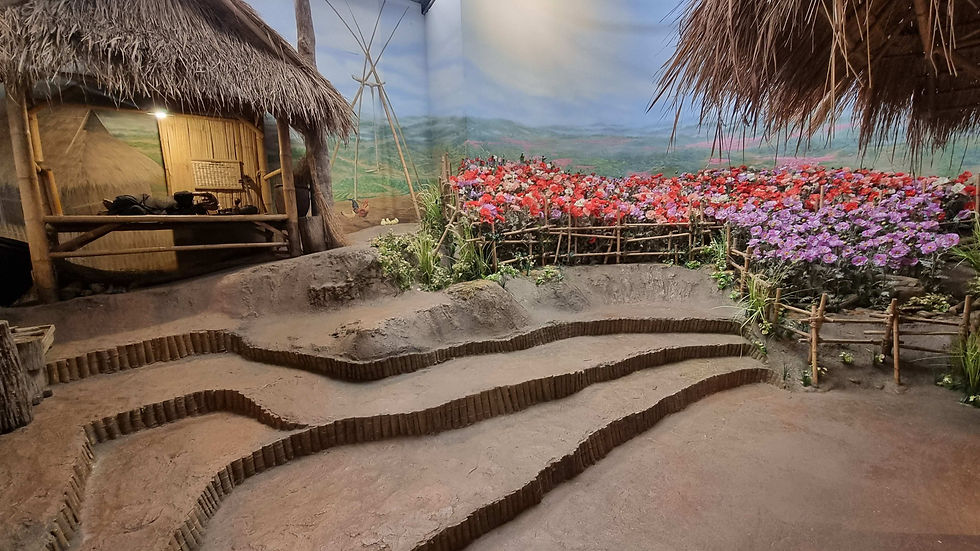House of Opium Museum
- Shannon
- Sep 22
- 3 min read
Updated: Oct 23
Tracing the Legacy of a Drug Empire
The House of Opium museum is a privately operated exhibition space tucked away near the Thai-Myanmar border in the small town of Sop Ruak. Opened in 1989, the museum was created not only to preserve antique opium related memorabilia but also to provide a historical lens through which to understand the complex and often tragic legacy of the opium trade in Southeast Asia. Its founder, passionate about local history, saw a need to document the region’s lesser known narrative, one that interweaves addiction, colonial influence and underground economies. The museum has since become a cultural landmark in northern Thailand, drawing visitors from around the world who are curious about the darker facets of the region’s past.

The museum's location is significant, it lies in the heart of the infamous Golden Triangle, a term coined to describe the rugged mountainous region where the borders of Thailand, Laos and Myanmar converge. This area, framed by the mighty Mekong and Ruak rivers, was once the epicentre of the global opium trade. In its heyday, the Golden Triangle was virtually lawless, a shadowland where drug lords operated with impunity and vast fields of poppies bloomed in the misty hills. Governments struggled to control the area and for decades, it remained a hotbed of trafficking, violence and clandestine operations. Its reputation became legend, fueled by media portrayals and real world conflicts that turned it into one of the most notorious drug producing regions on Earth.

Opium itself is a substance with a long and complex history in Southeast Asia. Derived from the sap of the opium poppy, the drug was originally used by indigenous hilltribes for a variety of reasons like medicinal pain relief, spiritual rituals and recreational use were all common. These practices were deeply embedded in the local cultures, long before Western powers began to exploit the trade for profit. The colonial era exacerbated this exploitation, as British and French interests pushed for greater production and distribution of opium across their territories, embedding addiction and dependence into the very fabric of many communities. What began as a plant of ritual and remedy evolved into an instrument of addiction, control and death.

The Vietnam War marked a turning point in the global spread of opium derivatives, particularly heroin. American troops stationed throughout Southeast Asia often found themselves grappling with trauma, fear and the psychological toll of war. Heroin became an escape, a way to momentarily numb the horrors of conflict. This spike in demand further incentivised local drug producers, who ramped up production to meet the needs of both local users and foreign markets. As heroin flooded the black market, the Golden Triangle solidified its place as a global powerhouse in narcotics trafficking. Entire communities became entangled in the trade, either through cultivation, processing or smuggling, leading to widespread violence and corruption that still remains today.

Inside the House of Opium museum, visitors are met with an impressive and sobering collection of more than 2000 artefacts. The displays range from ornate opium pipes and intricately carved smoking pillows to delicate measuring weights, scales and ceremonial knives used in traditional hilltribe rituals. Many of these objects are over two centuries old and represent a unique blend of craftsmanship and cultural history. Informational panels accompany the artefacts, offering detailed explanations about their use and the socio-economic context in which they were created. This hands on approach to history invites reflection on how such beautiful objects were tied to a trade that brought so much devastation.
🗺️ Location
212, Moo 1, Tambon Wiang, Umpoe Chiang Saen, Chiang Rai Province
🚆 How to get there
The House of Opium is located in Chiang Saen district, across the road from the famous Golden Triangle scenic area and a 5 minute walk from the Thailand/Myanmar border check point. It is about an hour from Chiang Rai by car. We bundled a visit here with a full day tour of the areas famous temples and paid roughly 1500THB each for the whole day.
⭐ Attraction Info
The museum is open from 7am - 7pm daily, with tickets priced at 50 THB per person. Guided tours are available for those who want deeper insight into the exhibits and photography is permitted in most areas. Visitors are encouraged to allow at least 1 hour to fully explore the extensive collection and learn about the Golden Triangle’s turbulent history.



























